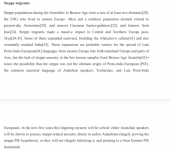Angela
Elite member
- Messages
- 21,823
- Reaction score
- 12,329
- Points
- 113
- Ethnic group
- Italian
I don't completely agree with this post from Anthrogenica, but it's thought provoking:
"
 Originally Posted by homosapien
Originally Posted by homosapien  There is no backbone to these discussions.
There is no backbone to these discussions.
A year back all these discussions centered around R1a and how it came from steppe. Now that it is evident all the malta boys and poltavka's turn out to be not relevant to the south asian R1a (L657) the discussions are turning into a autosomal discussion.
Ofcourse it goes without saying the leaders on the steppe studies are themselves to blame for the turn.
L657 is 5500 to 6000 years old. Show L657 in large numbers and entering into South Asia and the discussion is closed, but that seems impossible because after combing through all the samples in the north none has been found. So what does this say about where L657 originated is unknown as of now.
Regarding autosomal studies if they are honest they should estimate the effective population size of the so called MLBA_East and also estimate the population size of IVC and then proceed to show how there is steppe found even in Mala and some tribals.
JUst saying "oh we found steppe in MLBA_East which is the closest and the right fit based on our statistics" and all south asians also have it. So steppe came here. That just sound nuts. This makes one think are there guys really biologists or just statisticians.
Personally i feel the autosomal based conclusion which is again based on just 3 outliers is going to be untenable. Even if the IPE outliers are the real represenation of IVC which spanned half of modern India they have been UNABLE to show how it spread through the whole of the population and the percentage of the steppe component is more or less the same (factoring in strict or loose endogamy depending on their caste).
Sooner or later the conclusion of this paper is going to fall."
Where indeed is the proper clade of R1a?
"
 There is no backbone to these discussions.
There is no backbone to these discussions.A year back all these discussions centered around R1a and how it came from steppe. Now that it is evident all the malta boys and poltavka's turn out to be not relevant to the south asian R1a (L657) the discussions are turning into a autosomal discussion.
Ofcourse it goes without saying the leaders on the steppe studies are themselves to blame for the turn.
L657 is 5500 to 6000 years old. Show L657 in large numbers and entering into South Asia and the discussion is closed, but that seems impossible because after combing through all the samples in the north none has been found. So what does this say about where L657 originated is unknown as of now.
Regarding autosomal studies if they are honest they should estimate the effective population size of the so called MLBA_East and also estimate the population size of IVC and then proceed to show how there is steppe found even in Mala and some tribals.
JUst saying "oh we found steppe in MLBA_East which is the closest and the right fit based on our statistics" and all south asians also have it. So steppe came here. That just sound nuts. This makes one think are there guys really biologists or just statisticians.
Personally i feel the autosomal based conclusion which is again based on just 3 outliers is going to be untenable. Even if the IPE outliers are the real represenation of IVC which spanned half of modern India they have been UNABLE to show how it spread through the whole of the population and the percentage of the steppe component is more or less the same (factoring in strict or loose endogamy depending on their caste).
Sooner or later the conclusion of this paper is going to fall."
Where indeed is the proper clade of R1a?


